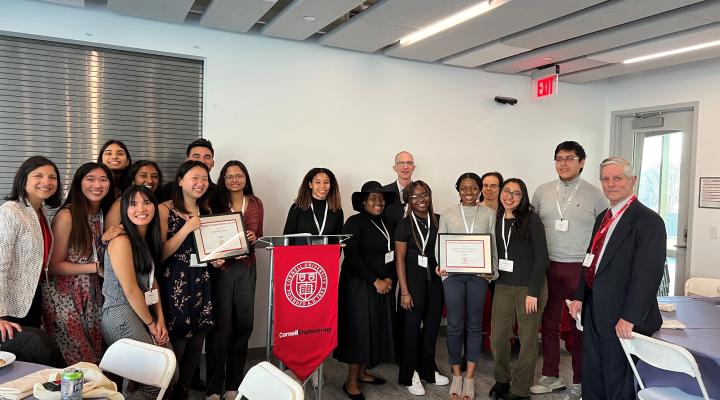By Erin Philipson
The Mechatronics course in the Sibley School of Mechanical and Aerospace Engineering fulfills the circuits requirement for mechanical engineering majors and has been a student favorite for many years – incorporating hands-on experience, teamwork, and competition into one course. Hadas Kress-Gazit, Professor in the Sibley School alternates teaching this course with Ben Finio, a lecturer in the Sibley School.
In a normal, non-pandemic semester, students gain hands-on experience building and analyzing circuits during their weekly lab sections. In addition, the students work in teams to design, fabricate, and program a microprocessor-controlled robotic vehicle, which is entered into a class-wide competition at the end of the semester known as Robotics Day.
For obvious reasons, the Fall 2020 semester looked very different from previous years. This year, David Hartino, Sibley School teaching support specialist, mailed students electronic kits, created by him and Finio, which included an oscilloscope, Arduino board, microprocessor, batteries, motors, sensors, circuit elements (resistors, capacitors, diodes, op-amp, etc), and breadboards - allowing students to complete hands-on activities as part of their homework, and design and build their own devices as part of an open-ended final project with motors, circuits, and sensors, from their own homes.
Students worked independently rather than in groups on the open design project which culminated in a virtual showcase rather than the customary robotics competition. While the projects looked different this year, there were some advantages.
“With an open design project, we really got to see the student’s creative side,” said Kress-Gazit. “We had projects that ranged from watering plants to learning support robots, to beautiful kinetic art and so much more! In addition, students got to experience the whole design, fabrication, and testing process on a project they were passionate about”.
Students could choose from three prompts for the project that included home and office automation, kinetic art, or submit their project to the Human-Robot Interaction (HRI) Conference student competition. The project required four components - sensing, actuation, computation, and circuits. To achieve this task, students could use anything from their mailed-home kits or their household and were given a $20 budget for other materials needed.
Kress-Gazit and the course staff were extremely impressed by the projects both in terms of creativity and the videos students created to present their projects. Fitting with the COVID-19 experience, the showcase began with a video created by Lindsey Woo in which she presented a robot to take of your mask. TAs then chose and presented videos from their student groups for the bulk of the showcase. To end, Kress-Gazit sent students off with a video created by Natalie Morris where she displayed a robot playing a holiday tune on the xylophone – welcoming them to their much-deserved winter break.
The at-home kits were such a success that they will be incorporated into the class permanently. Students could learn and discover at their own pace instead of being locked into the 2 ½ hour lab to accomplish their tasks. “They had time to reflect if they needed which I think was really important,” says Kress-Gazit.
"The final project built on concepts and components we had learned in previous assignments,” says Thomas Moura-Cook ’22. “The completely open-ended design project was daunting at first, but let us create something we were truly interested in. These factors resulted in an immensely valuable and gratifying experience."






